Libraries Build Tailored Program Plans to Improve Youth Outcomes
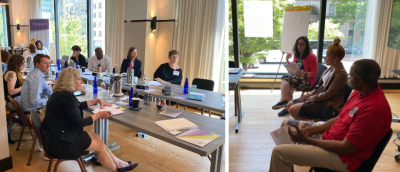
Written by Katie Sullivan, Program Manager, Urban Libraries Council
Eleven representatives from leading libraries gathered in Washington, D.C. from May 31 to June 2, 2023, for a convening focused on developing program plans that will effectively serve opportunity youth[1]. Opportunity youth, also known as “at-risk youth,” are at highest risk of involvement with the criminal justice system. This Urban Libraries Council-hosted event encouraged library participants to think critically about the youth they serve and to develop program plans that are responsive to their needs and support their well-being.
Key takeaways included:
1. Libraries should seek to understand and respond to the developing adolescent brain.
“Adolescence is a period of transition,” said speaker Dr. Kimberly Garza of Roanoke College. “During this time, they will experience more and faster growth than at any other time in their lives.”
Brains in adolescence, a period that some define as ages 10 to 19 but others puberty to 25, have not developed adult decision-making skills[2]. This stage is characterized by increased risky behaviors and rates of morbidity and mortality. Normal adolescent development also includes conflict, insecurities, mood swings and more.
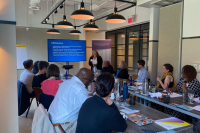
Pictured: Dr. Kimberly Garza, Roanoke College
Regardless of these challenges, experiences in adolescence can have long-lasting effects. Adolescents who experience trauma or challenges in family life can trigger a search for solutions with negative consequences. Behaviors such as alcohol and drug use and delinquency can begin in this period and shape adult lives.
The impressionability of the adolescent brain provides libraries with significant space to make an impact on the lives of youth in their programs. Libraries can provide youth with a safe and understanding space and introduce them to positive role models.
Additional Resources:
- Annie E. Casey Foundation | The Road to Adulthood: Aligning Child Welfare Practice With Adolescent Brain Development
2. Libraries should incorporate youth voice into program design and consider individual needs.
“For young people to be engaged, we need to make them feel like they are in a safe space,” said panelist Melissa Milchman, Senior Grants Manager and Juvenile Justice Specialist for the DC Office of Victim Services and Justice Grants.
Co-design is a process through which libraries can include youth in the development of programs that serve them. Libraries can deploy surveys, focus groups or one-on-one conversations with youth in their library to assess what would draw them and keep them in library programs.
Libraries can also place youth in leadership roles, formal or informal, that will build their confidence and investment in the program. Participant Jamie Griffin, Assistant Director for Creative Outreach & Special Projects at Memphis Public Libraries, shared that this is something that Memphis has been working on: “We are hoping to have teen counselors in our library system. We want them to share with each other and build their own space.”
3. Equity should be a throughline through all program components, not an afterthought.
“Equity is about looking at the largest picture possible,” ULC Director of Racial Equity and Community Impact Michelle Hamiel shared with the group. “Who does not benefit from this? Who is negatively impacted by the decision that we’ve made? It’s about using the equity lens for everything.”
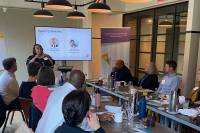
Pictured: Michelle Hamiel, Director of Racial Equity and Community Impact, Urban Libraries Council
Equity means not just providing opportunities but accounting for and addressing the lack of opportunities faced by specific communities or individuals. Libraries should consider addressing barriers that may be preventing residents from coming to programs, such as young parents who may need a safe space to leave their children. In cases where residents may face transportation challenges, consider providing transportation or moving the program to community hubs rather than expecting attendees to travel. Program times for children or parents should not take place during the typical school or workday.
Equity should be a part of every decision, including program staffing. Library staff should reflect the diversity of the community.
Additional Resources:
- Urban Libraries Council | Leadership Brief: Anti-Racist Executive Leadership for Public Libraries
4. Libraries should prioritize community outreach.
Reaching youth at risk of incarceration may be a challenge in and of itself since opportunity youth may not regularly visit the library. “Having someone like an outreach specialist who is well connected in your area can help you stay connected to young people and keep them coming back,” said panelist Nataly Del Valle, a Youth Peer Advocate at the DC Department of Youth Rehabilitation Services. “And make sure it’s somebody who really knows [the community], not just anybody.”
Outreach staff can connect with youth by visiting community hubs such as low-income or public housing complexes, barbershops and laundromats.
Additional Resources:
- Community Wealth Partners | Sharing Power with Communities: A Field Guide
- Public Libraries Online | Using Co-Design as an Approach to Better Serve and Engage Low-Income, Latinx Communities
5. Libraries should commit time and resources to building relationships with elected officials and other key stakeholders.
Anthony Smith, Executive Director of Cities United, spoke on the importance of communicating with local officials. “Most people don’t know who runs libraries,” said Smith. “How are you all showing up in conversations outside of your library? Are you showing up at different tables? If libraries were not as important to me, would I call folks into the conversation? How do you insert yourselves more?”
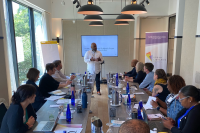
Pictured: Anthony Smith, Executive Director, Cities United
Identifying and honing in on the influential figures in the local jurisdiction is key to program effectiveness and sustainability. Library directors and CEOs should insert themselves into the conversations of their county or city leaders and if needed, push back on the budget given to them.
Additional Resources:
- Urban Libraries Council | Engaging Elected Officials on Democracy
The libraries that attended this event are participants in ULC’s Creating Youth Opportunities Initiative, which is supported by the Walmart.org Center for Racial Equity through a grant from Walmart. The Center supports local and national efforts to test and scale approaches that decrease the likelihood that opportunity youth will become involved in the justice system. Participating libraries will submit their completed program plans later this year for implementation in 2024.
[1] Who are Opportunity Youth? https://www.aspencommunitysolutions.org/who-are-opportunity-youth/
[2] National Library of Medicine: https://www.ncbi.nlm.nih.gov/books/NBK545476/
Related Articles
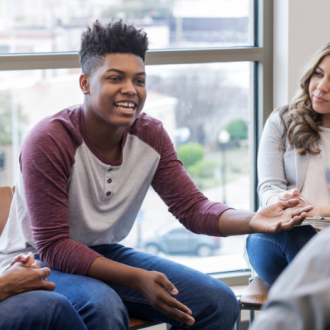
Libraries Serve Youth at Risk of Incarceration
With the support of the Walmart.org Center for Racial Equity, the Urban Libraries Council is working to build a body of research on how libraries are working with African American youth. This initiative is called Creating Youth Opportunities.
Read More

Guiding Public Libraries in Racial Equity to Achieve Racial Justice
In order for libraries to move forward in racial equity, people of color must be truly heard, received and valued. A racially equitable library will have a framework or a strategic plan with a clear mission and vision.
